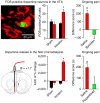Reward and motivation in pain and pain relief
- PMID: 25254980
- PMCID: PMC4301417
- DOI: 10.1038/nn.3811
Reward and motivation in pain and pain relief
Abstract
Pain is fundamentally unpleasant, a feature that protects the organism by promoting motivation and learning. Relief of aversive states, including pain, is rewarding. The aversiveness of pain, as well as the reward from relief of pain, is encoded by brain reward/motivational mesocorticolimbic circuitry. In this Review, we describe current knowledge of the impact of acute and chronic pain on reward/motivation circuits gained from preclinical models and from human neuroimaging. We highlight emerging clinical evidence suggesting that anatomical and functional changes in these circuits contribute to the transition from acute to chronic pain. We propose that assessing activity in these conserved circuits can offer new outcome measures for preclinical evaluation of analgesic efficacy to improve translation and speed drug discovery. We further suggest that targeting reward/motivation circuits may provide a path for normalizing the consequences of chronic pain to the brain, surpassing symptomatic management to promote recovery from chronic pain.
Figures



References
-
- Fields HL. Pain: an unpleasant topic. Pain. 1999;6:S61–S69. suppl. - PubMed
-
- Lee MC, Tracey I. Unravelling the mystery of pain, suffering, and relief with brain imaging. Curr. Pain Headache Rep. 2010;14:124–131. - PubMed
-
- Redgrave P, Gurney K, Reynolds J. What is reinforced by phasic dopamine signals? Brain Res. Rev. 2008;58:322–339. - PubMed
Publication types
MeSH terms
Grants and funding
LinkOut - more resources
Full Text Sources
Other Literature Sources
Medical

